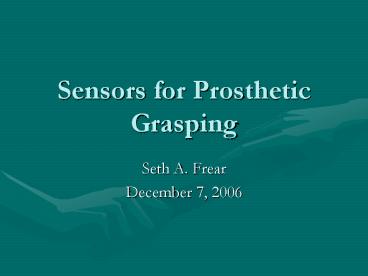Sensors for Prosthetic Grasping - PowerPoint PPT Presentation
1 / 33
Title:
Sensors for Prosthetic Grasping
Description:
... the user can further increase grip strength by flexing muscle again. ... If motion is detected the grip strength of the hand is automatically increased ... – PowerPoint PPT presentation
Number of Views:121
Avg rating:3.0/5.0
Title: Sensors for Prosthetic Grasping
1
Sensors for Prosthetic Grasping
- Seth A. Frear
- December 7, 2006
2
What is so difficult about grasping something
with a prosthetic hand?
3
The main difficulty comes from determining
whether or not something is slipping.
4
- The quality of a prosthetic arm is determined
not only by the mechanical complexity, but also
by the presence of a sensory system that will
allow for grip optimization and the ability to
quickly and efficiently complete tasks.
5
Examples of Robotic Hands
6
Different approaches to detecting and
compensating for slip
- Vibration sensors
- Force sensing resistors
- Force vector control
- Optical sensors for motion detection
7
Three papers
- Experimental development of a sensory control
system for an upper limb myoelectric prosthesis
with cosmetic covering (Andrea Tura Claudio
Lamberti Angelo Davalli Rinaldo Sacchetti) - - force sensing resistors
- - optical sensors
- Thick-film force, slip and temperature sensors
for a prosthetic hand (A Cranny D P J Cotton P
H Chappell S P Beeby N M White) - - vibration sensors
- The tactile slip sensor Integration of a
miniaturized sensory device on a myoelectric hand
(G Puchhammer) - -force vector control
8
What is myoelectric?
- A myoelectric signal is an electrical impulse
that produces muscle contraction in the body - Typically these signals have frequencies ranging
from a few hertz to about 300 hertz and voltages
ranging from around 10 microvolts to 1 millivolt
9
Paper one
- The first paper discusses the fitting of a 2
degree of freedom Otto Bock hand with a sensorial
system
10
- Without a sensory system visual feedback is the
only thing the wearer can use to control the
prosthesis. This can be tiring and slow - To improve upon this the authors of this paper
wanted to develop a system with involuntary
feedback so the wearer would not have to
explicitly control every aspect of the gripping
motion
11
Visual feedback vs. involuntary feedback
12
- The sensory control system the authors used
incorporates force-sensing resistors. - -Force sensing resistors consist of two thin
films of polymers, one is covered by a
network of interlaced electrodes and the other
by a semiconductor material. When no force is
applied the resistance is high when force is
applied, the semiconductor comes is contact with
the electrodes creating a drop in resistance.
13
Force-sensing resistor setup
14
Operation of the sensory hand
- Myoelectric impulse is generated by flexing
muscle - On receiving the impulse the hand begins to close
- The closing action stops once a pre-determined
contact threshold is reached - Once contact has been reached automatically , the
user can further increase grip strength by
flexing muscle again.
15
What about slipping?
16
Optical sensors were incorporated
- If motion is detected the grip strength of the
hand is automatically increased - The optical sensors allow the contact threshold
to be lowered so delicate objects can be gripped
without damage
17
Examples
18
Problems with this approach
- Robustness and durability of the FSR
- Varying of the film offset of the FSR resulting
in inaccuracies in the signals - Optical sensors only function well in optimal
light setting - Optical system was not actually installed on the
prosthesis (it was too big)
19
Paper two
- The second paper discusses the use of thick-film
piezoresistive static strain sensors for grip
strength and piezoelectric dynamic sensors
(vibration sensors) to detect slipping
20
- The sensors are located on stainless steel
cantilever structures fastened to the finger tips
of the prosthetic hand - Temperature sensors are also included to allow
for temperature compensation of the force sensors
as well as prevent thermal damage to the
prosthesis
21
Sensor setup
22
Static force sensor average normalized output
23
Dynamic and thermal sensors
24
Strain distribution
25
Problems with this approach
- Delicate sensor setup
- Inadequate sensor sensitivity
- Sensor drift
- Very smooth surfaces may not provide enough
vibration for the sensor to detect
26
Paper three
- The third paper discusses the use of force vector
control in the gripping of an object - Force vector control has actually been
implemented in prosthetic hands currently in use
27
Force vector control
- In most cases the coefficient of friction of an
obstacle is not known
28
A common range of coefficients of friction are
established creating a force cone as illustrated
below
29
As more weight is added the force vector changes
but is still within the friction limits
30
The weight is about to exceed the friction limits
31
To keep the object from slipping additional
gripping force is exerted
32
Problems
- Does not work well with objects that are very
smooth or rough (out of the coefficient of
friction range)
33
Conclusion
- All the examples discussed today use automatic
grip adjustment no sensory feedback to the
actual person controlling the hand - A method of transmitting feeling to the person
controlling the prosthesis would be optimal































